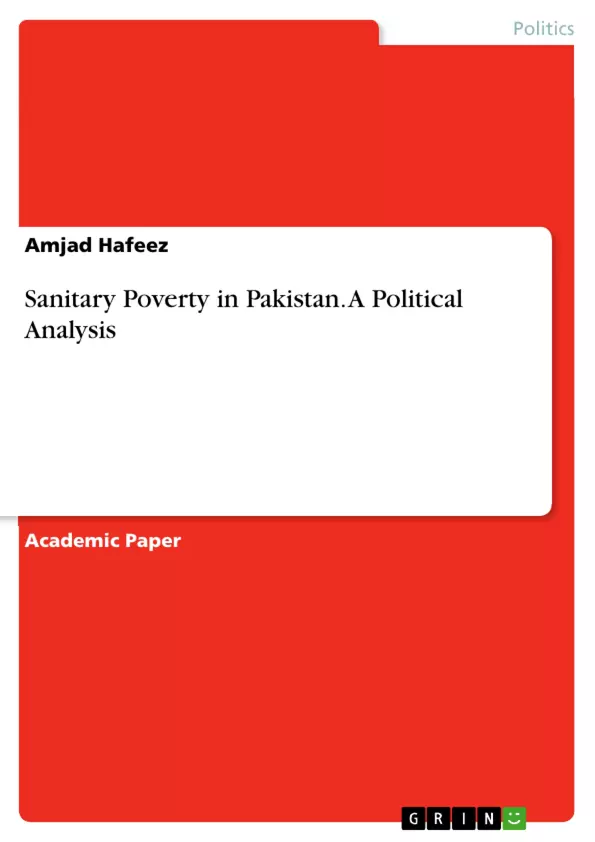This academic paper analyses the Sanitation Poverty in Pakistan. Pakistan’s population is 207 million people. 22 million people do not have access to clean water. While 79 million people don't have a decent toilet. Nearly 19,500 children under 5 die each year from diarrhoea, which is caused by dirty water and poor toilets. Poor WASH facilities are linked to diarrhoea among children below age of 5. Diarrhoea causes immediate weight loss, intestinal damage and nutritional malabsorption among children below age 5, and one of the contributing factors towards malnutrition and stunting among children.
The stunting rate for Pakistan is 45% in children under 5. Households with lower incomes and poverty have poor sanitation facilities. Along with that, social and cultural aspects also contribute towards open defecation. Domestic animals are one of the major sources of livestock which contributes approximately 56% of value addition in agriculture and nearly 11% to the gross domestic product. Livestock waste is often found within rural households. Animal dung is also used as fuel for cooking purposes. Therefore, problem tree analysis links sanitation issue with cultural, social and economic factors, resulting in poor health conditions, malnutrition and stunting in children. There have been interventions from international organizations and Government of Pakistan, which has improved the sanitation situation between 2000 and 2015.
However, these have not been able to provide satisfactory results. Resultantly, Pakistan is still among top 10 worst countries in the world on sanitation services list. Political Economy analysis of the situation suggests that weak institutional structure at third tier of governance and non-participatory approach of local councils combined with the lack of enough finances have been major hurdle in eradication of this issue. Therefore, it is important that involvement of district governments in all interventions through village and union councils is ensured along-with possible taxation for sanitation services to collect revenue. This approach will bridge the institutional and financial gap to solve the crisis.
Inhaltsverzeichnis (Table of Contents)
- Sanitation Poverty in Pakistan (Problem Statement):
- Search Method:
- Grey Literature:
- Peer-reviewed Literature:
- Literature Review:
- Problem and Statistics:
- Causes of the Problem:
- Political Factors:
- Economic Condition of Targeted Population:
- Cultural Factors:
- Absence of Drainage Infrastructure:
- Social Factors:
- Implications:
- Objective Tree for Sanitation Poverty:
- Works Cited:
Zielsetzung und Themenschwerpunkte (Objectives and Key Themes)
This study aims to analyze the problem of sanitation poverty in Pakistan using a problem tree and political economy approach. The study investigates the root causes of the issue, including political, economic, social, and cultural factors. It examines the impact of inadequate sanitation on public health, particularly among children, and explores the effectiveness of past interventions by international organizations and the government.
- Sanitation Poverty in Pakistan
- Political Economy Analysis of Sanitation
- Impact of Inadequate Sanitation on Public Health
- Role of Government and International Organizations
- Institutional and Financial Barriers to Sanitation Improvement
Zusammenfassung der Kapitel (Chapter Summaries)
- Sanitation Poverty in Pakistan (Problem Statement): This chapter introduces the problem of sanitation poverty in Pakistan, providing statistics on the prevalence of poor sanitation and its consequences, particularly for children. It highlights the link between sanitation, health, and poverty and emphasizes the need for addressing the issue.
- Search Method: This chapter discusses the research methodology employed in the study. It explains the sources of information, including grey literature and peer-reviewed literature, and outlines the search strategy used to identify relevant materials.
- Literature Review: This chapter summarizes the existing literature on sanitation poverty in Pakistan. It examines the problem, its statistics, and the causes behind it, including political, economic, social, and cultural factors. The chapter also discusses the implications of inadequate sanitation on public health.
- Objective Tree for Sanitation Poverty: This chapter presents a problem tree analysis to illustrate the interconnectedness of various factors contributing to sanitation poverty. It helps to identify the root causes of the issue and potential areas for intervention.
Schlüsselwörter (Keywords)
The key words and focus topics of this study are: sanitation poverty, Pakistan, political economy analysis, public health, children, malnutrition, stunting, water and sanitation, WASH (Water, Sanitation and Hygiene), grey literature, peer-reviewed literature, international organizations, government interventions, institutional barriers, financial constraints, problem tree analysis.
- Citar trabajo
- Amjad Hafeez (Autor), 2019, Sanitary Poverty in Pakistan. A Political Analysis, Múnich, GRIN Verlag, https://www.grin.com/document/462665



